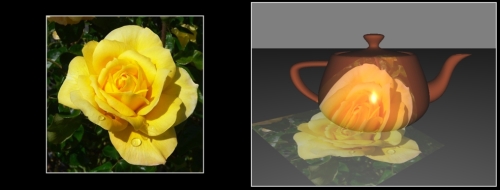Applying a projected texture
We can apply a texture to the objects in a scene as if the texture was a projection from a hypothetical "slide projector" located somewhere within the scene. This technique is often called projective texture mapping and produces a very nice effect.
The following images show an example of projective texture mapping. The flower texture on the left (Stan Shebs via Wikimedia Commons) is projected onto the teapot and plane beneath.

To project a texture onto a surface, all we need to do is determine the texture coordinates based on the relative position of the surface location and the source of the projection (the "slide projector"). An easy way to do this is to think of the projector as a camera located somewhere within the scene. In the same way that we would define an OpenGL camera, we define a coordinate system centered at the projector's location, and a view matrix (V) that converts coordinates to the projector's coordinate system. Next, we'll define a perspective...























































